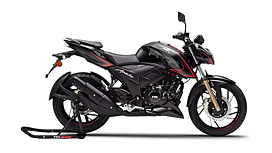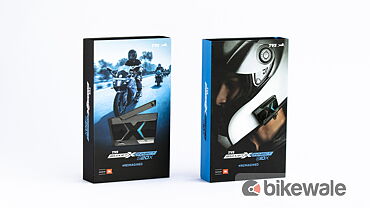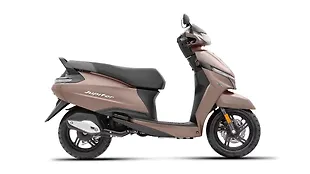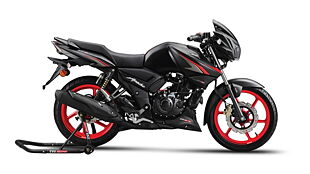Introduction

Two bikes. Two different body styles yet we’re doing a comparison test. Why? Because, both get almost the same set of features, technology and also the same set of buyers. And these bikes are easily the most accessible and affordable performance motorcycles under Rs 1.5 lakh.
While the Bajaj Pulsar RS200 is a year old motorcycle, it still has a decent amount of fan following in the country. The Apache RTR 200 4V on the other hand, doesn’t carry the same brand value as the Pulsar, but still manages to convince a lot of buyers to walk into the TVS showrooms. But this time, the walk-ins will be way more than what any other Apaches have ever got. Why? Read the next paragraph!
Looks & Styling

Striking! That’s the word you use when you see the Apache 200 for the first time. This TVS looks the way a naked street motorcycle is supposed to – aggressive, sharp and attractive. There’s no unnecessary usage of parts to make the Apache stand out, rather TVS has stuck to use of minimal body components to get that sleek look. The big angular fuel tank, sharp headlamp assembly and double barrel exhaust –all these are well thought and complements the overall styling of the bike.
But looks like Bajaj had a different thought process. Their quest to design a unique fully-faired motorcycle resulted in a very busy, quirky design language for the Pulsar RS200. Unlike TVS, Bajaj has used up lot of parts to give it a big bike feeling, which might’ve worked but such styling doesn’t last long. That massive front fairing that houses the projector headlamps is surely not the best in the industry. There are a lot of curves and cuts on it, few might like it but majority won’t. From the rear three quarter, the Pulsar RS200 does look like a bike that’s supposed to feel big (remember the SS400, it has the same design and parts) but unfortunately, that’s the only positive thing about this style. And yes, look at the brake light assembly design, chances are you’ll have a mixed reaction.
TVS Apache RTR 200 4V: 8.5/10
Bajaj Pulsar RS 200: 8/10
Ergonomics & Quality

The quality of the Pulsar RS200 is way better than what we’ve seen in other Bajajs. The paint and the switchgear quality, the plastics used all around the bike is pretty good. What I didn’t like is the plastic around the cluster – it feels and looks little cheap. Operating the switchgear feels good on the Pulsar RS200 – there’s a sense of little premiumness to it. The Apache RTR 200 doesn’t disappoint here. Its quality levels is on par with the Pulsar RS200 and has the best paint quality. The matte finish on the Apache is excellent.

Between both the bikes, the ergonomics of the Apache RTR 200 feels better and easy adaptable to a wide range of riders. The tall wide clip-on handler bar, slightly rear-set footpegs, wide cushy seat gives you the ability to stay on the bike for longer durations. And a six-foot tall guy like me didn’t feel cramped on this TVS at all and there’s more than enough space on the bike to move around. The Pulsar RS200 is more like a hybrid of supersport and naked bikes when it comes to the sitting position. You sit upright, well almost, but thanks to the not-so tall handlebar and rear-set pegs, you also get a sporty riding position and that’s what a lot of riders like. But during braking, you’ve to hug the tank with your thighs hard if you don’t want a lot of pressure on your wrists. Also, the seats on the Pulsar RS200 are pretty hard and that spoils the overall experience.
TVS Apache RTR 200 4V: 8/10
Bajaj Pulsar RS 200: 8/10
Features & Technology

Here, both the bikes – the RS200 and the Apache RTR 200 4V are equipped equally with features and technologies. The best feature of the Apache – the instrument cluster is easily the best in the segment and also better than bikes in the segment above. The rectangular LCD screen displays tonnes of ride data including lap timer. You’ve the option of adjusting the rpm shifter light too. There’s daytime running lamps (DRL) on the Apache, USB charger under the seat and there’s fuel injection too. TVS is offering the Apache with two tyre options– TVS Remora and Pirelli.

The Pulsar RS200 is also equipped with the DRLs, instrument cluster that has side stand and service indicators. Fuel injection is standard, just like projector headlamps, back light on the switchgear which acts like a feel good factor. The bike is also equipped with LED turn indicators and taillight – same as the Apache 200. The Pulsar RS200 has an edge over the Apache in the gearbox department as the former gets a six-speed whereas the latter is equipped with a five-speed transmission.
TVS Apache RTR 200 4V: 7/10
Bajaj Pulsar RS 200: 7.5/10
Engine & Performance

The Pulsar RS200 is a clear winner here. It gets liquid-cooling, fuel injection, has the highest power figure – 24bhp and 18.6Nm and this engine is mated to a six-speed gearbox. But the major highlight of this engine is its refinement, smoothness and lack of vibrations (something we see in most of the Pulsars). This engine just doesn’t feel harsh when ridden hard and that’s very likeable. Linear power delivery and quick acceleration makes the RS200 a fun bike to ride in the city as well as highways. The bike reaches the 100kmph mark with a blink of an eye and has the capability to touch 130kmph with ease. Interestingly, minute vibrations comes in at 100kmph and there’s no change in its intensity even if you are doing 130kmph. In short, 100kmph is a good cruising speed for the Pulsar RS200. The gearbox is smooth and offers precise one-down five-up shifts.
The Apache RTR 200 4V loses out on liquid-cooling, displacement and also on the power figure. This 198cc engine produces 20.73bhp and 18.1Nm of peak torque and is oil-cooled. Gearbox is five-speed but it works seamlessly. But this engine doesn’t feel exciting and fun like the Pulsar RS200. The lack of power on the Apache makes the Pulsar RS200 look like the king of the street and it does in some ways. The engine on the Apache is refined and smooth but fails to match up the Pulsar RS200. In terms of performance, the power delivery is linear and accessible in the city as well as on the highways but again, the RS200 feels so much better.
TVS Apache RTR 200 4V: 8/10
Bajaj Pulsar RS 200: 7/10
Ride, Handling & Braking

It was a very close call here, but the winner is the Pulsar RS200. While the RS200 lost on the ride quality front, it easily made it up in the handling and the braking departments. The suspension setup on the RS200 is on the firmer side and that isn’t really friendly for a rider who’ll spend most of the time in the city. Plus, the hard seats makes matter worse. The Apache is softer, thanks to the well-tuned suspension setup and the seats are comfortable too. Result? You will feel at home when the Apache glides over bad roads or when you try to ride over uneven roads.

In the handling department, the Pulsar RS200 feels so much better, especially at the corners. There’s good feedback from the front, but could’ve been better if there wasn’t so much fairing weight on the front. Quick direction changes are easy and the bike is stable at high speeds. The Apache too, is a very good handler, but it just doesn’t feel as dynamic and agile as the Pulsar RS200. Yes, the front feels light as there’s no weight like the RS200 at the front, and that helps in manoeuvring in heavy traffic conditions. In the corners, the Apache is brilliant – thanks to the responsive chassis and the Pirelli tyres.

When it comes to braking, the RS200 performs way better than the Apache. It gets a single-channel ABS unit and bigger front brake disc. The bite of these brakes is pretty good and you feel them on the levers. This brake setup will surely be appreciated by the experienced riders. The ones on the Apache are good too, but doesn’t have the same amount of bite and feel. We tested the non-ABS version, however, there’s a dual-channel ABS unit from Bosch that comes as an option. Unfortunately, this model hasn’t launched yet. If you’re are an amateur rider, we recommend you go for this version instead of the non-ABS. It’s safe and that’ll make your experience better and safer. Wheelie fans, the bad news is both the bikes get rear-wheel lift mitigation and that won’t let you perform an endo. For that, there’s a non-ABS version.
TVS Apache RTR 200 4V: 7.5/10
Bajaj Pulsar RS 200: 8/10
Fuel Efficiency

The TVS Apache RTR 200 4V returned 41.57kmpl in our fuel efficiency test. So basically, you get a tank range of close to 500kms on this TVS. The Pulsar RS 200 was marginally more fuel efficient at 42.38kmpl and with a 13 litres fuel tank capacity, you’re looking at a range of approximately 550kms in one tank full.
TVS Apache RTR 200 4V: 5/10
Bajaj Pulsar RS 200: 6/10
Price & Warranty

Price & Warranty
The Apache RTR 200 4V fuel injected version with the Pirelli tyres retails for Rs 1.19 lakh (on-road Bangalore) and carries a warranty of 3 years or 30,000kms. The Pulsar RS200 non-ABS version is priced at Rs 1.34 lakh, whereas the ABS version retails for Rs 1.47 lakh (on-road Bangalore). The warranty for the RS 200 is 2 years or 24,000kms.
TVS Apache RTR 200 4V: 5/10
Bajaj Pulsar RS 200: 4.5/10
Desirability

I usually desire things that are popular and in this case, it’s the Pulsar RS200. Since its birth, the Pulsar had a crazy fan following, not because it is a Bajaj bike but because this brand was always linked to performance. And performance is usually associated with coolness and style in case of the Indian youth, so in terms of desirability the Pulsar RS200 is a clear winner here.

TVS has always tried to market the Apache with the racing scene in India, however, the result wasn’t effective, at least not as much as the Pulsar.
TVS Apache RTR 200 4V: 6/10
Bajaj Pulsar RS 200: 7/10
Verdict

Rank 1:
Final scores: 73.5/100
The Pulsar RS200 is a great attempt by Bajaj to offer a product which has the right set of features, technology, performance and style (overdone here) and all these at an affordable price point. It has a very nice engine, gearbox and not to forget the safety aspect too – the ABS and all these things have made the Pulsar RS200 an exciting and fun bike to own.
Rank 2:
Final scores: 69.5/100
The Apache RTR 200 4V looks brilliant and safety wise, it’s equipped well too; no doubt there, but these days the Indian consumers look for more than just great style. They need performance and the ability to go fast, which the Apache fulfils but not to a great extent. But if you’re genuinely limited to a budget of Rs 1.20 lakh, then the Apache is really a great buy.
Photography by Kapil Angane
Final Scores
| Parameters/Models | Max Points | Bajaj Pulsar RS 200 | TVS Apache RTR 200 4V |
| Rank | 1 | 2 | |
| Looks & styling | 10 | 8 | 8.5 |
| Ergonomics & Quality | 10 | 8 | 8 |
| Features & Technology | 10 | 7.5 | 7 |
| Engine & Gearbox | 10 | 8.5 | 7 |
| Performance | 10 | 8 | 7.5 |
| Ride quality | 10 | 7.5 | 8 |
| Handling & Braking | 10 | 8.5 | 7.5 |
| Fuel Efficiency | 10 | 6 | 5 |
| Price & Warranty | 10 | 4.5 | 5 |
| Desirablility | 10 | 7 | 6 |
| Total | 100 | 73.5 | 69.5 |
| Price (OTR, Mumbai) | Rs 1.19 lakh on-road Bangalore | Rs 1.47 lakh on-road Bangalore |
Gallery
1/47
TVS Apache RTR 200 4V vs Bajaj Pulsar RS200
Double Tap to Zoom
























































